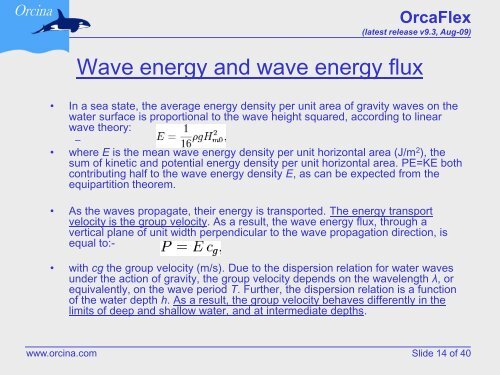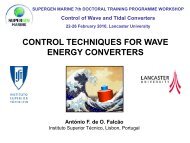OrcaFlex - Engineering Department
OrcaFlex - Engineering Department
OrcaFlex - Engineering Department
You also want an ePaper? Increase the reach of your titles
YUMPU automatically turns print PDFs into web optimized ePapers that Google loves.
<strong>OrcaFlex</strong><br />
(latest release v9.3, Aug-09)<br />
Wave energy and wave energy flux<br />
• In a sea state, the average energy density per unit area of gravity waves on the<br />
water surface is proportional to the wave height squared, according to linear<br />
wave theory:<br />
–<br />
• where E is the mean wave energy density per unit horizontal area (J/m 2 ), the<br />
sum of kinetic and potential energy density per unit horizontal area. PE=KE both<br />
contributing half to the wave energy density E, as can be expected from the<br />
equipartition theorem.<br />
• As the waves propagate, their energy is transported. The energy transport<br />
velocity is the group velocity. As a result, the wave energy flux, through a<br />
vertical plane of unit width perpendicular to the wave propagation direction, is<br />
equal to:-<br />
• with cg the group velocity (m/s). Due to the dispersion relation for water waves<br />
under the action of gravity, the group velocity depends on the wavelength λ, or<br />
equivalently, on the wave period T. Further, the dispersion relation is a function<br />
of the water depth h. As a result, the group velocity behaves differently in the<br />
limits of deep and shallow water, and at intermediate depths.<br />
www.orcina.com Slide 14 of 40







